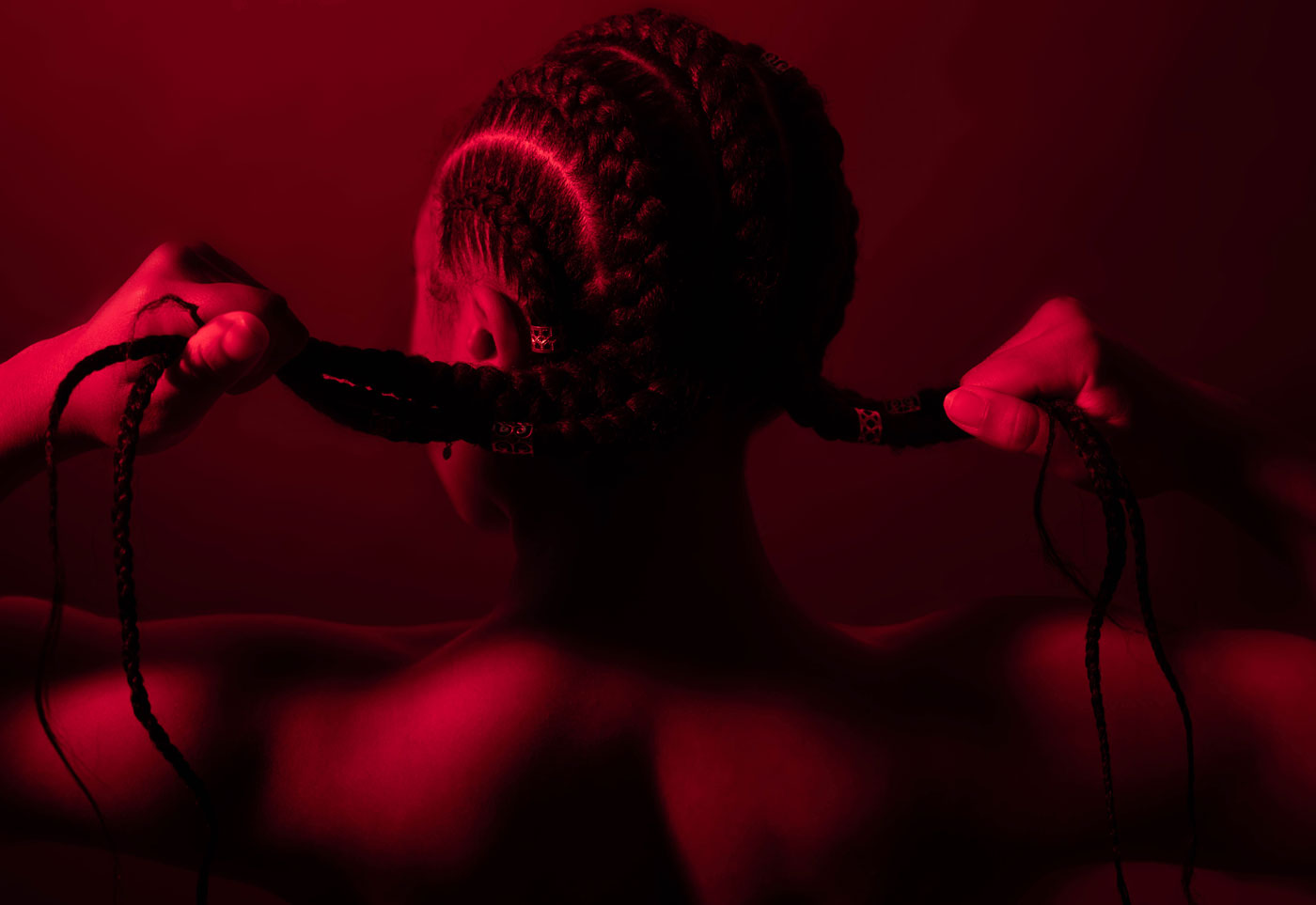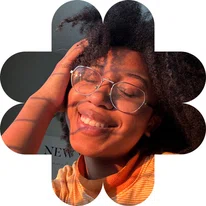

Strength

Height: 8” x Width: 12“ | Idea(s): I wanted to include symbolism in my photos that are fueled by the colors I use. Material(s): Canon 6D, Photoshop, red strobe light with can | Process(es): Set up for butterfly lighting, set up red gel, grabbed the braids, and put the camera on timer | Curatorial Note: An evocative monochromatic photograph. Excellent alternative approach to a portrait, where we don’t see the face. The bold saturated reds, strong contrasts of light and dark, and tightly braided hair gripped by the hands parallel the strength in the person depicted in the image.
Eden Campbell
Student statement
Student statement
Please describe the context for how the idea for this artwork originated (was this part of your sustained investigation, an independent project, a class assignment, created during a summer study, etc.).
My idea for my portfolio had been how color influences emotion. Our class assignment had been to take a picture for our portfolio, and I’d been feeling particularly powerful that day. I’d just gotten my hair done, and my hair and my ethnicity are such strong sources of symbolism to me. I wanted to show it off, show myself off, show raw, unadulterated power and strength that blackness can often feel collectively.
In what ways did you practice and experiment when developing your sustained investigation?
Well, I knew that I shot with color most of the time even before we’d started practicing for and developing our portfolios. I started questioning why that was, because it didn’t seem like an incredibly common photography style to have a color from light overwhelming a photo. My portfolio was me really learning how to capture ideas and emotions in my style and learning why its look was unique. Through my portfolio, I learned color theory and how to make color an irremovable and signature feature in my art.
I wanted to showcase how color, color combinations, color contrast, and other aspects of light affect the message or mood of a photo/how powerful the impact of it.
How did you demonstrate revision in your sustained investigation?
When I started my portfolio, my symbolism in my photos had been somewhat loose, and the color had been an accent. If the photo had been changed to black and white, the photo would lose something but not overwhelmingly, So, in the middle I decided I wanted my photos to rely upon their colors; if they lost their color, they lost most of their substance, and at the end, I decided that even though color was a vital part of my process, the photo (the sketch) itself should be strong enough to stand on its own without color, and the color (the paint) should make it soulful, enhance every nuance, and make the photo bleed with passion and story. Throughout my portfolio I changed the role that color should play and how intimately it would be involved in symbolism and story versus mainly enhancing its technical proficiency.
Your work was selected in part because it achieved synthesis. Can you explain your intentionality in choosing materials and developing processes to further your ideas?
Well, for all my photos I tried to make the framing, coloring, and materials cohesive with the idea. If the photo was about denial, the subjects would be spatially separated and the area between barren, but a line of symmetry still connects them. The more emotionally intimate, the closer the photo or louder the subject. The more overwhelming and chaotic, the higher the contrast, value and color-wise, and the more cluttered the props.
Since the simplicity and complexity, intimacy and coldness was cohesive and varied with each photo, each photo is different in emotion, and yet the color and variation remains constant. It creates a cohesive catalog of colorful experiences.
How did your materials and process(es) choices shape the creation or meaning of your artwork(s)?
Most of the time, if I took a photo and it didn’t end up how I pictured it in my head, and the environment/materials had their way, I’d just roll with it. Seldomly did my pictures turn out exactly like what they looked like in my head, and seeing the potential and uniqueness in the differences was what I think gave my art more soul. Rather than force something to happen, whether with the lighting of a prop or an angle, just letting it happen and then perfecting the imperfection, just letting the mood sway me, trying out new things during shooting was I think what allowed flexibility and ease in my concepts. Then, of course, editing the final shot allows for bringing attention to subtle details that otherwise might’ve been missed. Each tiny detail adds up to enhance the entire photo.
How did your art teacher support your artistic development?
Mr. Adams, my photography teacher all four years, was just awesome. When he liked what I did, he made sure that I knew it, and just the same, when he saw something that sucked, he’d be like “Hey! Sucks a little bit!" It took me a long time to hit my stride, almost a year and a half, and he was patient with me the whole time. When I was going through hard stuff, he supported me the whole time. When I was getting better, he pushed me the whole time. He taught me literally everything I know, gave me all the resources I needed, and I have never had a teacher feed a spark in me like he did. He cared, and he still does. Mr. Adams is a teacher that truly, with his entire heart, cares. I wouldn’t be here, I wouldn’t be the photographer and maybe even the person I am if it wasn’t for him. I can’t even put into words everything he’s done or how grateful I am.
How did your school leadership (principal, assistant principal, guidance counselor, etc.) support your growth as an art student? This could be classroom visits, attending art shows, talking to you about your goals, etc.
Well, I didn’t actually have a ton of interaction with my school leadership, but I know the principal and assistant principal did attend some art shows. I actually couldn’t say, because while I did win a couple art shows, I often missed the awarding ceremonies because I also had to perform with the color guard, which often happened at the same time.
What is your advice to other AP Art and Design students?
My advice to other AP students would be, for real, everyone makes art that sucks sometimes, and it doesn’t define you as a person or an artist. Photography was a class I chose by accident, it was just a class to me until it wasn’t and then— I still sucked!! And guess what? That didn’t matter because I was having fun anyway! Immediately after my first good photo, I made an equally crappy one, and another after that and after that. I shrugged, smiled, and said, “They can’t all be winners,” and that’s something I live by to this day. (I created my next two weeks later.) You won’t create a masterpiece every time and that’s OK; love making it anyway. Enjoy and relish in the process of learning through every mistake anyway. Keep falling in love with your craft anyway. The love and curiosity for your craft is what keeps you excelling and moving forward; no natural ability or skill will ever compare to your desire to learn.
Devon Christopher Adams
Williams Field High School, Gilbert, AZ, USA
Leader statement
Leader statement
What are you most proud of regarding your school’s AP Art and Design program, student, and teacher?
We are proud of the robust AP Art and Design program's approach where students can work with an analog approach to their art with one instructor or choose the other instructor for a digital approach to their artistic approaches. These two arms of the program work together to enhance a mulitmodal, interdiscplinary approach to the upper-level art and design programs in our school.
What do you do to support visual arts programming in your school?
To support visual arts in our school's programming, we encourage students by having a fall and spring art show to showcase performing and visual arts. In our program, we build in scaffolding to encourage students to take multiple visual arts pathways through their four years here, ultimately leading to the visual arts capstone diploma seal program.
What is your advice to other school leaders on how to support an AP Art and Design program?
Build programs that do two things. First, make sure the students are aware that the arts are as important as academics and sports. Finding the balance between these three approaches builds programs for the needs of all students. Secondly, it's important to find those students who seem to get lost and help encourage their interests within the arts. Show them avenues they may not consider through field trips, entrepreneurships, and relationships between community and school.

Eden Campbell



